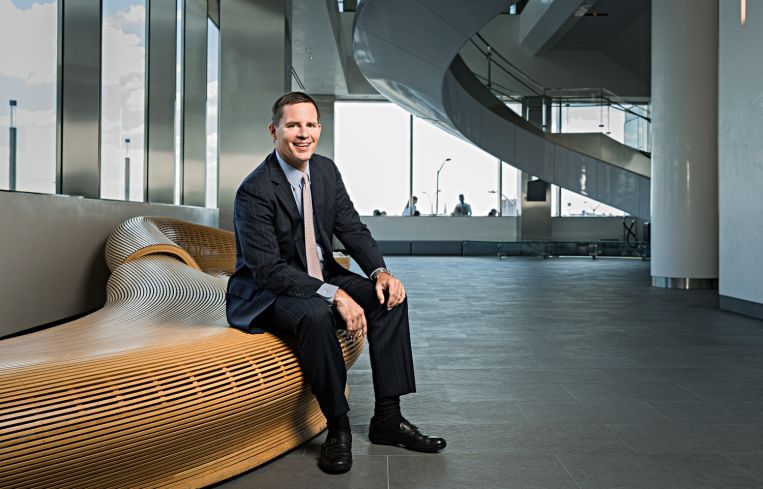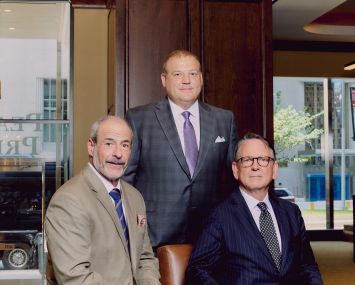Lab Fab: The New Breed of Collaborative Science Developments
By Cathy Cunningham October 27, 2016 10:45 am
reprints
“Chemistry is the study of matter,” Walter White once opined on Breaking Bad. “But I prefer to see it as the study of change.”
If you take matter (in this case, brick and mortar real estate) and you factor in change (the rising price of this matter), what you’re left with are fewer places to study heady topics like chemistry.
Enter Alexandria Real Estate Equities’ new endeavor in New York City: Alexandria LaunchLabs.
This is a 50/50 laboratory-office space aimed at encouraging innovation from students and seed-stage life science companies. The concept is almost similar to WeWork—but for life science.
LaunchLabs will be located in the West Tower of the 728,000-square-foot Alexandria Center for Life Science campus in Manhattan. It will comprise roughly 15,000 square feet of turnkey laboratory/office space with access to shared lab equipment. The initiative is slated to launch next June, and space can be rented by the desk—starting at $1,995 per month, or by the lab. In conjunction with the opening of LaunchLabs, Alexandria will provide seed-stage capital to support emerging life science companies.
Whether they are students, professors, post-docs or entrepreneurs, early-stage companies can get a leg-up by applying to the seed fund. “It’s something we’re creating ourselves right now,” said John Cunningham, the regional market director of New York City and strategic operations at Alexandria Real Estate Equities, a real estate investment trust. “We’re trying to nurture the ecosystem by providing the opportunity to fund entrepreneurs through a seed fund. We have a $10 [million] to 25 million dollar fund for working with these seed- to early-stage companies. So we’ll administer, run and oversee it.”
Alexandria’s campus, located at 430 and 450 East 29th Street between First Avenue and the Franklin D. Roosevelt Drive, was constructed by the REIT beginning in 2007 as a collaborative urban campus for life science companies. The campus, which is nearly 100-percent-leased, currently comprises two towers, and a third tower is now potentially en route. From 20 air changes per hour, to behemoth industrial glass-washing rooms that ensure sterilized apparatus, this isn’t your average office development.
Tenants include established pharmaceutical companies and academic medical centers such as Eli Lilly and Company, Roche, NYU Langone Medical Center and Pfizer’s Center for Therapeutic Innovation but also emerging startups and biotechnology entrepreneurs fresh out of school.
When LaunchLabs is complete, it will accommodate up to 79 individual units in a 50/50 office-to-lab ratio. Several of the campus’ existing 32 tenants are at the A-round investment stage and already venture-backed. Those in LaunchLabs, on the other hand, will likely be in academic institutions and still pursuing grants. An individual user of LaunchLabs will be able to access everything needed to operate a lab and perform scientific research, from fume hoods to autoclaves to gases and everything in between.
“At that stage, many people are thrilled to have this available to them,” said Cunningham. “That is where the growth will come from in New York. We don’t see the growth being due to large companies relocating here.”
As an added bonus to being in the Alexandria Center, those in LaunchLabs will have access to other life science companies that are looking to collaborate, presenting a supercharged opportunity for them to establish themselves as an early-stage company.
“These are not inexpensive buildings to build even without the lab space,” Cunningham said. “It’s right on the river, and it’s a Class A environment and urban innovation campus. But we really wanted to make it as affordable as possible, so we’re heavily subsidizing it, if you will, where someone can get a lab bench and an office desk for $1,995 a month.”
The space is relatively affordable for budding science entrepreneurs, given the upscale environment that surrounds it, including two restaurants—one of which is Tom Colicchio’s Riverpark, an award-winning urban farm and restaurant (you actually walk past the farm to get to the restaurant, giving new meaning to “farm-to-table”), a fitness center and a waterfront esplanade.
Stop, Collaborate and Listen
In a seemingly growing trend, another example of real estate development meeting technical advancement is Cornell University’s multilevel, collaborative campus, Cornell Tech. As previously reported by Commercial Observer, Cornell is developing more than 2 million square feet of educational, commercial and residential space just south of the formerly-called Queensboro Bridge for its graduate engineering program.
The university won the rights to develop the 12-acre former site of the Coler-Goldwater Specialty Hospital on Roosevelt Island. On campus is The Bridge, a 240,000-square-foot structure being developed by Forest City Ratner Companies. The idea behind the building is to have tech companies at different career lifecycles in one campus. By having tech grad students, the up-and-comers and established firms all in one location, the new innovators of the world can intermingle and share ideas.
Mary Ann Tighe, the chief executive officer of the New York tri-state region at CBRE, discussed the project on Oct. 13 while moderating a panel on new office construction in New York City—part of the brokerage’s third-quarter market briefing. “It’s the first time, I think, in our city…where industry and academia come together in the same structure,” she said.
There will only be 120,000 square feet available to house corporate users at The Bridge, emphasizing the collaborative nature of the campus. “The intention is that nobody should have more than 10,000 square feet,” Tighe said. “You know that heavily used word ‘curate’? We’re looking to put together a mix of companies that can interact with a student and faculty population. What I think you will see for the first time is a place designated in our city where the future comes together with the present in the form of student, faculty and corporate tenants. So keep your eye on this.”
Katie Bicknell, a senior vice president at Forest City, underscored the draw of partnering with academic talent.
“As we have conversation with companies, for sure, talent is a key part of the story,” Bicknell told CO in June. “Another key part of that story is the opportunity to partner and to collaborate with the incredible talent that is at Cornell Tech.”
Behind the Curtain: a New Industry
When it comes to life science specifically, Alexandria and BioMed Realty Trust—the latter acquired by affiliates of Blackstone Real Estate Partners in January—are the only two REITs focused exclusively on the niche. “There are other groups that dabble in it, if you will, but nobody does what [Alexandria does] in terms of venture investments,” Cunningham said. “And I can’t overemphasize the value of being here, in New York. We’re essentially creating a new industry in Manhattan.”
Although REITs are typically known for their secrets, Alexandria is known for its transparency. It was awarded its second consecutive NAREIT Investor CARE Gold Award for quality of communication methods and transparency of disclosures in June. As a peek behind the curtain, Cunningham gave CO a tour of the REIT’s ever-expanding campus where real estate investment and life science innovation intersect.
“It’s neat. I’ve developed everything from office buildings to warehouse buildings, to retail, to everything else,” said Cunningham. “I’ve been doing this for 20 years now, and there’s nothing quite like it.”
The campus began as a New York City Economic Development Corporation (EDC) Request for Proposal in 2005, under former mayor Michael Bloomberg’s administration. Alexandria beat out competitors from all over the world to develop the site, despite not having any presence in New York City at the time or any experience developing here. Not an easy pitch.
When “the EDC asked [Joel Marcus, Alexandria’s chief executive officer and founder,] what else he had developed in New York City he replied ‘nothing,’ ” Cunningham recounted. “Then they asked ‘How many employees do you have here?’ and he said ‘none.’ ”
What Alexandria did have in its favor was that it had already carved out significant experience within life science development. The company went public in 1997 and had become, what Cunningham describes as the “gold standard” for commercial laboratory space around the world. “Nobody does what we do, not only from the real estate side but in that we also have an investment group, Alexandria Venture Investments, which has invested over $350 million in [life science] companies.”
Alexandria gravitated toward New York City specifically because of its academic and medical institutions, including The Rockefeller University, Weill Cornell Medicine, Mount Sinai, Columbia University Medical Center and Memorial Sloan Kettering Cancer Center. Although life-science research was being carried out throughout these hallowed New York institutions, there hadn’t been any commercial life science space in Manhattan prior to 2005.
Today, each of the 32 tenants currently occupying the campus is researching cures for various diseases. And as with any other real estate investment, tenants must be rigorously underwritten. Understanding the tenant’s focus is paramount, which is why Alexandria has a science and technology team on hand to review the initial science presented.
Cunningham, who has been in commercial real estate development for 29 years, noted the stark differences between underwriting real estate and life science real estate. The factors evaluated include the type of science being undertaken, whether it’s cutting edge or old news, who the scientists themselves are, which institutions they are involved with, and who their mentors or affiliates are. “We’ve been doing this for so long that we know everybody and have co-invested with everyone who’s involved in science investment,” he said. “So it becomes a very small world at that point. You recognize what good opportunities are.”
In Good Company
Newcomers in LaunchLabs will be in good company in the Alexandria Center. Cellectis, an immuno-oncology and gene-editing company from Paris, is one example of the established companies on campus.
“Cellectis was the second highest initial public offering in the United States for immuno-oncology space after Juno [Therapeutics],” said Cunningham. “They were looking at [Cambridge, Mass.] because it’s the hottest market, but they came to us saying, ‘Look, we’re going to be about 40 people, and we want to form connections. We want to be able to penetrate New York City’s academic institutions because that is where the opportunities are.’”
Cunningham added that “they came here and immediately had multiple joint ventures or license deals with academic institutions like Weill Cornell and have been extremely pleased to have chosen New York,” Cunningham told CO. “The funny thing is that the CEO, André Choulika, did his post-doc work at Harvard. So it was kind of a no-brainer for him to choose Cambridge—but he thought he would make a bigger splash by being in New York.”
And Cellectis isn’t alone in selecting New York City. When global pharmaceutical company Eli Lilly and Company leased 100,000 square feet in the East Tower, Alexandria only had a steel frame constructed. It was 2009, and Lilly had just bought ImClone Systems—a biopharmaceutical company focused on advancing oncology care—for $6.5 billion. The plan was to relocate the company to Indianapolis, or to New Jersey where ImClone had facilities. Alexandria met with Lilly and persuaded them of the value proposition in Manhattan, and the company became the campus’s first tenant. Two years ago, Lilly had the first oncology treatments approved by the Food and Drug Administration from science that came out of New York.
In 2012, Roche Holdings announced it would establish its Translational & Clinical Research Center at the campus. Roche relocated from 12 miles away in Nutley, N.J., after being there for 82 years and signed an 11-year lease in the 419,000-square-foot West Tower. Within a year, Roche had over 50 collaborations, according to Cunningham. “Being proximate to academic and medical research institutions is really critical in life science. We refer to the locations as ‘urban innovation clusters,” he said.
The main clusters are currently Greater Boston, San Francisco, New York City, Seattle, San Diego, Maryland and the Research Triangle Park, N.C. “New York is the newest cluster, and there’s huge excitement about what can happen here,” he said.
In a release at the time, Roche reasoned its relocation to New York City would allow it to build on its connections to key stakeholders in the U.S., maintain interactions with FDA, and enhance collaborations with U.S.-based partners.
As the enticing of Cellectis, Lilly and Roche exemplify, Cunningham spends the majority of his time talking to chief scientific officers and heads of research, integrating them with the campus community and showing them the opportunities of being in New York for research. Something that is difficult to outsource. “The number of brokers in New York who actually understand life science lab space I can count on one hand,” he said.
A New Lease on Life (Science)
The EDC views New York City as an aggressively growing life science cluster with over 120 life science companies, the largest bioscience workforce in the U.S. and in excess of $1.4 billion in National Institutes of Health awards, according to the EDC’s website.
JRT Realty Group signed the NY Stem Cell Foundation to Taconic Investment Partners’ 619 West 54th Street in November 2015, making it the only other building except for Alexandria Center in Midtown where biotech companies are being placed. Although NYSCF is the first biotech firm to move in, Taconic believes it will be a catalyst for other firms and wishes to target the remaining 100,000 square feet to other biotech firms.
“Biotech is an evolving business sector that is gaining ground in New York City,” Greg Smith, president of JRT, told CO. “619 West 54th Street offers the location and physical characteristics required—heavy floor loads, high ceilings, necessary zoning, and the potential for backup generators. Taconic is well versed in the biotech sphere and understands the increased demand for this type of specific office/lab space. Taconic is sensitive to the desire on the part of New York-based biotech’s industries to grow the life science industry here in New York City,” he said.
The creation of the new industry isn’t without its challenges. The demand—although high—is still nascent, and finding potential new sites to develop life science lab space in the concrete jungle that is Manhattan is no mean feat. The purpose of clustering is that academic and medical institutions are close together, which allows for the people within them to walk back and forth and communicate with one another. “The companies want to be close to where the science is happening, because a lot of them are working in the lab at the academic institution and starting their own company at the campus,” Cunningham explained.
Another development-specific challenge lies in the requirements for laboratory/ office space, which can be so specific that very few buildings can be retrofitted to accommodate it. Alexandria’s campus has 20 air changes per hour, using 100 percent outside air, whereas most office buildings have only three to four air changes on average. So, the cost to retrofit an existing building is extremely high.
Bloomberg often returns to visit the campus that broke ground under his administration, using Apella (the event space) from time to time. “Bloomberg, when he was in office and after, stated that this [campus] is a proud accomplishment of his,” Cunningham said. “While he was in office he would bring finance ministers from other countries to show them how New York is diversifying. We also have great rapport with the De Blasio administration. They’re very focused on growing the life sciences community.”
Returns aside, the REIT’s end goal is simple, Cunningham said. “Our mission, really, is to help change human health. It’s a pretty lofty goal. The collaborations and successes that we are seeing among our New York City tenants are pretty unique opportunities that we’re helping facilitate.


